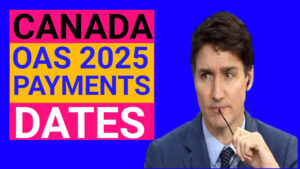As people grow older and step into retirement, managing money becomes even more important. In Canada, one key way the government helps is through a program called Old Age Security (OAS). This system gives seniors monthly payments to help cover their daily needs. It helps ensure that people aged 65 and above can enjoy their retirement years without worrying too much about income.
Unlike other benefits that are tied to your work history, OAS doesn’t need any past job experience or contributions. It is funded directly by the government using the country’s tax money. Whether you worked full-time or never had a job, as long as you meet the age and residency rules, you may qualify for this help.
OAS payments are adjusted every few months to keep up with inflation. That means if the cost of living goes up, the payments may increase too. Many seniors rely on this money along with the Canada Pension Plan (CPP) and other savings. This article will guide you through the payment dates, eligibility rules, how to apply, how much you can receive, and what happens if your income is high or low.
Overview of OAS Payments in Canada

Old Age Security is one of Canada’s oldest support programs for seniors. It started in 1952 and continues to help older citizens with basic living expenses.
- Who it’s for: Canadians aged 65 and older
- No contributions needed: You don’t have to pay into it during your working years
- Inflation protection: Payment amounts change every three months based on cost of living
This program works hand-in-hand with others like the Guaranteed Income Supplement (GIS) and the CPP to help retired Canadians live with dignity and financial peace.
When Will You Get Paid in 2025?
Here are the official OAS payment dates for 2025:
- Use Direct Deposit: To avoid late checks or delivery issues, use direct deposit—it’s quick and safe.
- Delays Possible: Some banks might take a couple of days to process the payment, especially on holidays.
Who Can Receive OAS Benefits?
To get OAS, you must meet some basic requirements related to age, residency, and citizenship:
- You must be 65 or older
- You need to be a Canadian citizen or legal resident
- If living in Canada: You must have lived in Canada for at least 10 years after turning 18
- If living outside Canada: You need at least 20 years of Canadian residency after turning 18
- Your work history doesn’t matter—you can still get OAS even if you never had a job or are still working
Also, OAS can still be paid even if you live in one of the 50+ approved countries outside Canada, as long as you meet the residency rules.
How to Apply for OAS Benefits
Some people are automatically enrolled in OAS. If not, you’ll need to apply on your own. Here’s how:
- Watch for a Letter: If you’re automatically enrolled, you’ll get a letter from Service Canada after you turn 64
- If No Letter Comes: Apply online or in person
- Documents You’ll Need: Proof of age, citizenship, and where you’ve lived
- Apply Online: Use your My Service Canada Account
- Or Apply Offline: Download a form from the Service Canada website or visit a local office
- Wait for Confirmation: After you apply, you’ll get details about your payment schedule
If you’re applying from another country, you may have to give extra proof of your Canadian residency.
How Much Money Can You Get from OAS?
The amount you get depends on your age and how long you’ve lived in Canada. Payments are reviewed every three months based on inflation.
- Extra for Older Seniors: If you’re 75 or older, your payment is about 10% higher
- Quarterly Changes: Payment amounts are updated every quarter to match inflation
Income and OAS: What You Should Know
There are some rules if you earn a high income or need extra support:
1. OAS Clawback (Recovery Tax)
If you earn more than $90,997 in 2025, you may have to repay part or all of your OAS benefits. This is called the OAS Recovery Tax. The more you earn above that amount, the more you repay.
2. Guaranteed Income Supplement (GIS)
If you have low income, you might get an extra payment through GIS. This is a non-taxable benefit and reviewed every year.
3. Taxable Income
OAS payments are considered taxable, so make sure to include them when filing your taxes. Talk to a tax advisor if you want to avoid surprises or extra charges.
Where Does the Money Come From?
OAS is funded by the Government of Canada’s general tax revenue. There are no deductions from your paycheck for this program, and employers don’t contribute either.
Because the funding comes from taxes, OAS is available to all who qualify, no matter how much or how little they’ve worked in their life. It’s a key part of Canada’s promise to support its aging population.